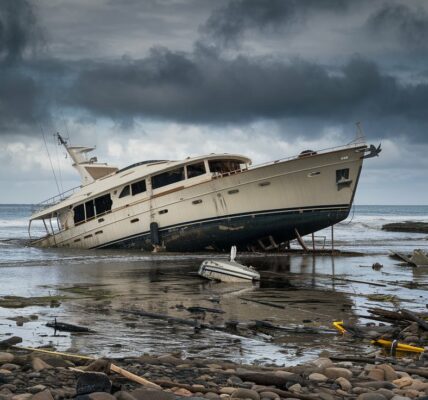HANOI, Vietnam – At least 127 people have been confirmed dead, and 54 others remain missing in northern Vietnam as the country grapples with the aftermath of Super Typhoon Yagi. The powerful storm struck on Saturday, leaving a trail of devastation with continued heavy rainfall, landslides, and widespread flooding across northern provinces.
Authorities have described Yagi as the most powerful storm to hit Vietnam in 30 years, bringing sustained winds of nearly 150 km/h (92 mph) and affecting millions of people. More than 1.5 million people have been left without electricity, and the damage to infrastructure is severe, with bridges collapsing, buildings destroyed, and entire communities stranded.
Scenes of Desperation and Loss
Thousands of people in hard-hit provinces were stranded on rooftops, unable to escape the rising floodwaters. In the Phu Tho province, dramatic dashcam footage showed the moment the Phong Chau bridge collapsed on Monday, plunging vehicles into the river below. Many residents turned to social media to post urgent pleas for help as rescue efforts struggled to reach isolated areas.
One resident, Phan Thi Tuyet, 50, shared her heartbreaking story with the AFP news agency: “I have lost everything, all gone,” she said, holding her two dogs. “I had to come to higher ground to save our lives. We could not bring any of the furniture with us. Everything is under water now.”
Across the region, the devastation is immense. In Thai Nguyen and Yen Bai provinces, entire one-storey homes were submerged, with residents waiting helplessly on their rooftops for rescue teams. The scale of the destruction is overwhelming, and emergency response teams are working around the clock to reach those still trapped.
Widespread Damage and Continued Threats
Typhoon Yagi has caused severe damage to Vietnam’s infrastructure. It tore roofs off buildings, destroyed factories, and triggered widespread landslides and flooding. At least 752 people have been injured, according to officials from the Ministry of Agriculture. The total number of missing persons remains at 64, with fears that this number may rise as rescue efforts continue.
Flood and landslide warnings have been issued across 401 communes in 18 northern provinces as the weakened storm continues its westward trajectory. Though now downgraded to a tropical depression, Yagi’s lingering effects, including torrential rains, remain a major threat.
The destruction has been compounded by pre-existing vulnerabilities in northern Vietnam’s geography, where heavy rains often lead to landslides and flooding in mountainous areas. Local officials are urging residents in high-risk areas to evacuate, while rescue teams scramble to reach those stranded.
A Regional Catastrophe
Vietnam is not the only country to have been ravaged by Typhoon Yagi. Before reaching Vietnam, the storm left 24 people dead across southern China and the Philippines, bringing widespread damage and displacing thousands of people.
Meteorologists have noted that typhoons like Yagi are becoming more intense, possibly influenced by climate change. While the direct connection between climate change and specific storms is difficult to pinpoint, warmer ocean temperatures are believed to contribute to stronger winds and heavier rainfall, exacerbating the impacts of these extreme weather events.
A Humanitarian Crisis
As the recovery process begins, the extent of Yagi’s devastation is becoming clearer. Thousands of homes, schools, and businesses have been destroyed, and the region’s agricultural sector, vital to local livelihoods, has been decimated. Local authorities are working with international aid organizations to deliver food, water, and medical supplies to affected communities, but the scale of the disaster presents enormous challenges.
The Vietnamese government has mobilized military and civilian rescue teams to respond to the disaster, with helicopters and boats being deployed to assist with rescue operations in isolated areas. However, many rural regions remain inaccessible due to damaged roads and bridges, further complicating rescue efforts.
The flooding has also raised concerns about waterborne diseases, as sanitation systems have been overwhelmed, and clean drinking water is in short supply.
Looking Ahead
As the storm weakens, Vietnam faces the monumental task of rebuilding. Authorities will need to assess the full extent of the damage, restore power, and assist those who have lost homes and livelihoods. With rescue operations still ongoing, the immediate priority remains saving lives and providing relief to those affected.
Typhoon Yagi’s devastating impact is a grim reminder of the growing frequency and intensity of extreme weather events in the region, which experts warn could become more common in a warming world.





